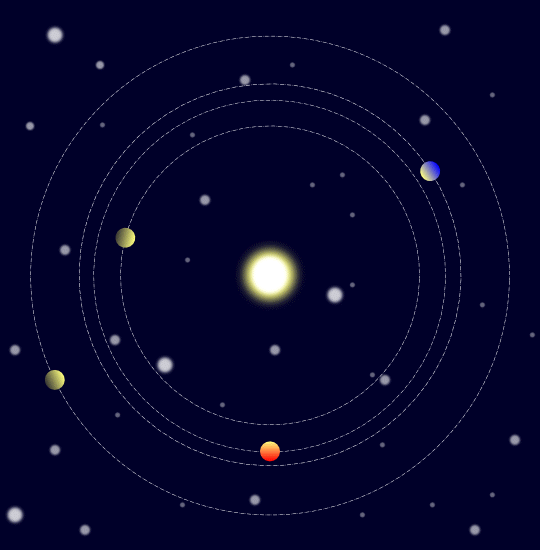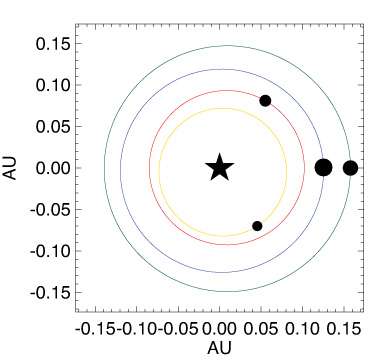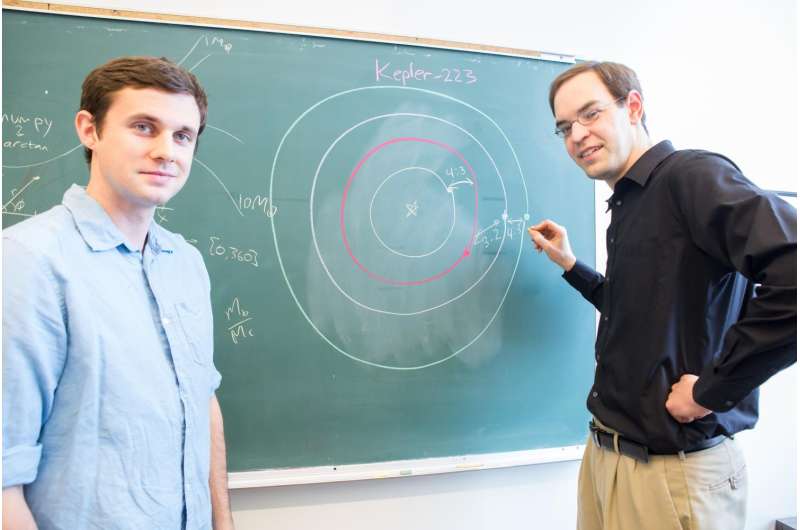Exoplanets' complex orbital structure points to planetary migration in solar systems

The four planets of the Kepler-223 star system seem to have little in common with the planets of Earth's own solar system. And yet a new study shows that the Kepler-223 system is trapped in an orbital configuration that Jupiter, Saturn, Uranus, and Neptune may have broken from in the early history of the solar system.
"Exactly how and where planets form is an outstanding question in planetary science," said the study's lead author, Sean Mills, a graduate student in astronomy & astrophysics at the University of Chicago. "Our work essentially tests a model for planet formation for a type of planet we don't have in our solar system."
These puffy, gaseous planets, far more massive than Earth, orbit close to their stars. "That's why there's a big debate about how they form, how they got there, and why don't we have one," Mills said.
Mills and his collaborators used brightness data from NASA's Kepler telescope to analyze how the four planets block the starlight and change each other's orbits, thus inferring the planets' sizes and masses. The team performed numerical simulations of planetary migration that generate this system's current architecture, similar to the migration suspected for the solar system's gas giants. These calculations are described in the May 11 Advance Online edition of Nature.
The orbital configuration of the solar system seems to have evolved since its birth 4.6 billion years ago. The four known planets of the much older Kepler-223 system, however, have maintained one orbital configuration for far longer.
The planets of Kepler-223 are much larger than Earth, likely consisting of a solid core and an envelope of gas, and they orbit their star in periods ranging from only seven to 19 days. Astronomers call these planets sub-Neptunes. They are the most common type of planets known in the galaxy.
Kepler-223's planets also are in resonance. Planets are in resonance when, for example, every time one of them orbits its sun once, the next one goes around twice. Jupiter's moons, where the phenomenon was discovered, display resonance.
Kepler-223's two innermost planets are in a 4:3 resonance. The second and third are in a 3:2 resonance. And the third and fourth are in a 4:3 resonance. Astronomers had seen extrasolar systems containing two or three planets in resonance, but not four.
"This is the most extreme example of this phenomenon," said study co-author Daniel Fabrycky, an assistant professor of astronomy & astrophysics at UChicago.

Formation scenarios
The Kepler-223 system provides alternative scenarios for how planets form and migrate in a planetary system that is different from our own, said study co-author Howard Isaacson, a research astronomer at the University of California, Berkeley, and member of the California Planet Search Team.
"Data from Kepler and the Keck Telescope were absolutely critical in this regard," Isaacson said. Thanks to observations of Kepler-223 and other exoplanetary systems, "We now know of systems that are unlike the sun's solar system, with hot Jupiters, planets closer than Mercury or in between the size of Earth and Neptune, none of which we see in our solar system. Other types of planets are very common."
Some stages of planet formation can involve violent processes, but during other stages, planets can evolve from gaseous disks in a smooth, gentle way, which is probably what the sub-Neptune planets of Kepler-223 did, Mills said.
"We think that two planets migrate through this disk, get stuck and then keep migrating together; find a third planet, get stuck, migrate together; find a fourth planet and get stuck," Mills explained.
That process differs completely from the one that scientists believe led to the formation of Earth, Mercury, Venus, and Mars, which likely formed in their current orbital locations.
Earth formed from Mars- or moon-sized bodies smacking together, Mills said, a violent and chaotic process. When planets form this way their final orbital periods are not near a resonance.
Substantial movement
But scientists suspect that the solar system's larger, more distant planets of today—Jupiter, Saturn, Uranus, and Neptune—moved around substantially during their formation. They may have been knocked out of resonances that once resembled those of Kepler-223, possibly after interacting with numerous asteroids and small planets (planetesimals).

"These resonances are extremely fragile," Fabrycky said. "If bodies were flying around and hitting each other, then they would have dislodged the planets from the resonance." But Kepler-223's planets somehow managed to dodge this scattering of cosmic bodies.
Other processes, including tidal forces that flex the planets, might also cause resonance separation.
"Many of the multi-planet systems may start out in a chain of resonances like this, fragile as it is, meaning that those chains usually break on long timescales similar to those inferred for the solar system," Fabrycky said.
Mills and Fabrycky's UC Berkeley collaborators were able to determine the size and mass of the star by making precise measurements of its light using the high resolution Echelle spectrometer on the 10-meter Keck I telescope atop Mauna Kea in Hawaii.
"The spectrum revealed a star very similar in size and mass to the sun but much older—more than six billion years old," UC Berkeley's Isaacson said. "You need to know the precise size of the star so you can do the dynamical and stability analysis, which involve estimates of the masses of the planets."
More information: Sean M. Mills et al, A resonant chain of four transiting, sub-Neptune planets, Nature (2016). DOI: 10.1038/nature17445
Journal information: Nature
Provided by University of Chicago



















